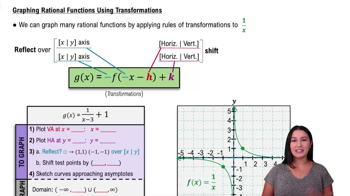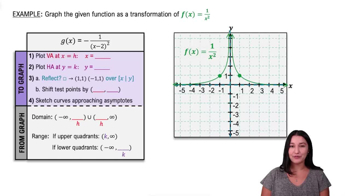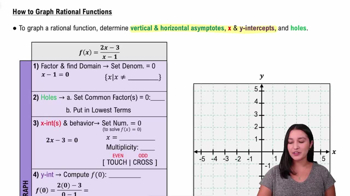Table of contents
- 0. Review of Algebra4h 16m
- 1. Equations & Inequalities3h 18m
- 2. Graphs of Equations43m
- 3. Functions2h 17m
- 4. Polynomial Functions1h 44m
- 5. Rational Functions1h 23m
- 6. Exponential & Logarithmic Functions2h 28m
- 7. Systems of Equations & Matrices4h 6m
- 8. Conic Sections2h 23m
- 9. Sequences, Series, & Induction1h 19m
- 10. Combinatorics & Probability1h 45m
5. Rational Functions
Graphing Rational Functions
Problem 77
Textbook Question
In Exercises 57–80, follow the seven steps to graph each rational function. f(x)=(x^2+x−12)/(x^2−4)
 Verified step by step guidance
Verified step by step guidance1
Identify the domain of the function by finding the values of x that make the denominator zero. Set the denominator equal to zero and solve for x: \(x^2 - 4 = 0\).
Factor the numerator and the denominator. The numerator \(x^2 + x - 12\) can be factored as \((x + 4)(x - 3)\) and the denominator \(x^2 - 4\) can be factored as \((x + 2)(x - 2)\).
Determine the vertical asymptotes by setting the denominator equal to zero and solving for x. These are the values that are not canceled out by the numerator.
Find the horizontal asymptote by comparing the degrees of the numerator and the denominator. Since both have the same degree, the horizontal asymptote is the ratio of the leading coefficients.
Identify any holes in the graph by finding common factors in the numerator and the denominator. If a factor is canceled out, it indicates a hole at that x-value.
Recommended similar problem, with video answer:
 Verified Solution
Verified SolutionThis video solution was recommended by our tutors as helpful for the problem above
Video duration:
5mPlay a video:
Was this helpful?
Key Concepts
Here are the essential concepts you must grasp in order to answer the question correctly.
Rational Functions
A rational function is a function that can be expressed as the ratio of two polynomials. In the given function f(x) = (x^2 + x - 12) / (x^2 - 4), both the numerator and denominator are polynomials. Understanding the properties of rational functions, such as their domain, asymptotes, and intercepts, is crucial for graphing them accurately.
Recommended video:

Intro to Rational Functions
Asymptotes
Asymptotes are lines that a graph approaches but never touches. For rational functions, vertical asymptotes occur where the denominator is zero (and the numerator is not zero), while horizontal asymptotes describe the behavior of the function as x approaches infinity. Identifying these asymptotes helps in sketching the overall shape of the graph.
Recommended video:

Introduction to Asymptotes
Graphing Steps
The seven steps to graph a rational function typically include finding the domain, intercepts, asymptotes, and analyzing end behavior. These steps provide a systematic approach to understanding the function's behavior and shape, allowing for a more accurate and comprehensive graph. Following these steps ensures that all critical features of the function are represented.
Recommended video:

Transformations of Exponential Graphs

 5:31m
5:31mWatch next
Master Graphing Rational Functions Using Transformations with a bite sized video explanation from Callie
Start learningRelated Videos
Related Practice




